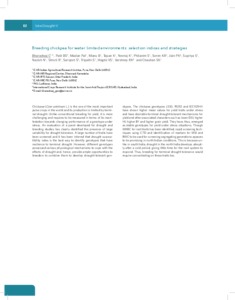Breeding chickpea for water limited environments: selection indices and strategies
Abstract
Chickpea (Cicer arietinum L.) is the one of the most important pulse crops in the world and its production is limited by terminal drought. Unlike conventional breeding for yield, it is more challenging and requires to be measured in terms of its manifestation towards changing performance of a genotype under stress. An evaluation of a panel developed for drought and breeding studies has clearly identified the presence of large variability for drought tolerance. A large number of traits have been screened and it has been inferred that drought susceptibility index is the best way to identify genotypes that have resilience to terminal drought. However, different genotypes possessed various physiological mechanisms to cope with the effects of drought and, hence, provide ample opportunities to breeders to combine them to develop drought-tolerant genotypes. The chickpea genotypes L550, PG112 and ICC92944 have shown higher mean values for yield traits under stress and have desirable terminal drought-tolerant mechanisms for yield and other associated characters such as lower DSI, higher HI, higher BY and higher grain yield. They have, thus, emerged as stable genotypes for yield under stress situations. Though MABC for root traits has been identified, rapid screening techniques using CTD and identification of markers for MSI and RWC to be used for screening segregating generations appears to be promising in north Indian conditions. This is because unlike in south India, drought in the north India develops abruptly after a cold period, giving little time for the root system to respond. Thus, breeding for terminal drought tolerance would require concentrating on these traits too

